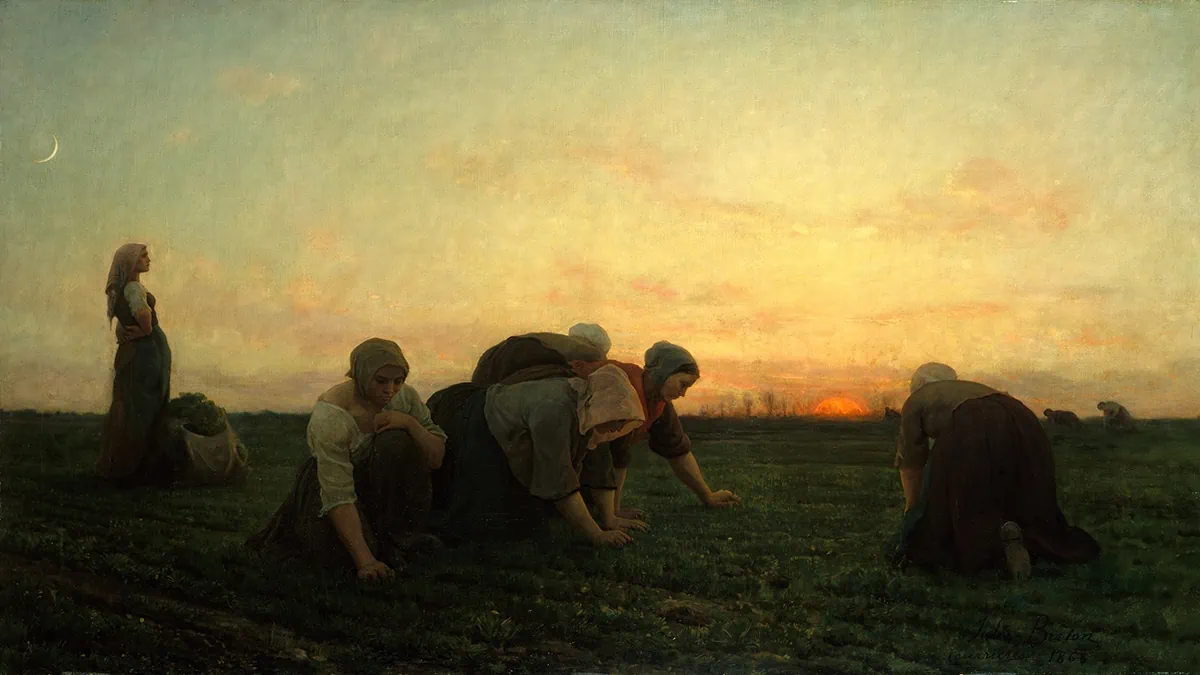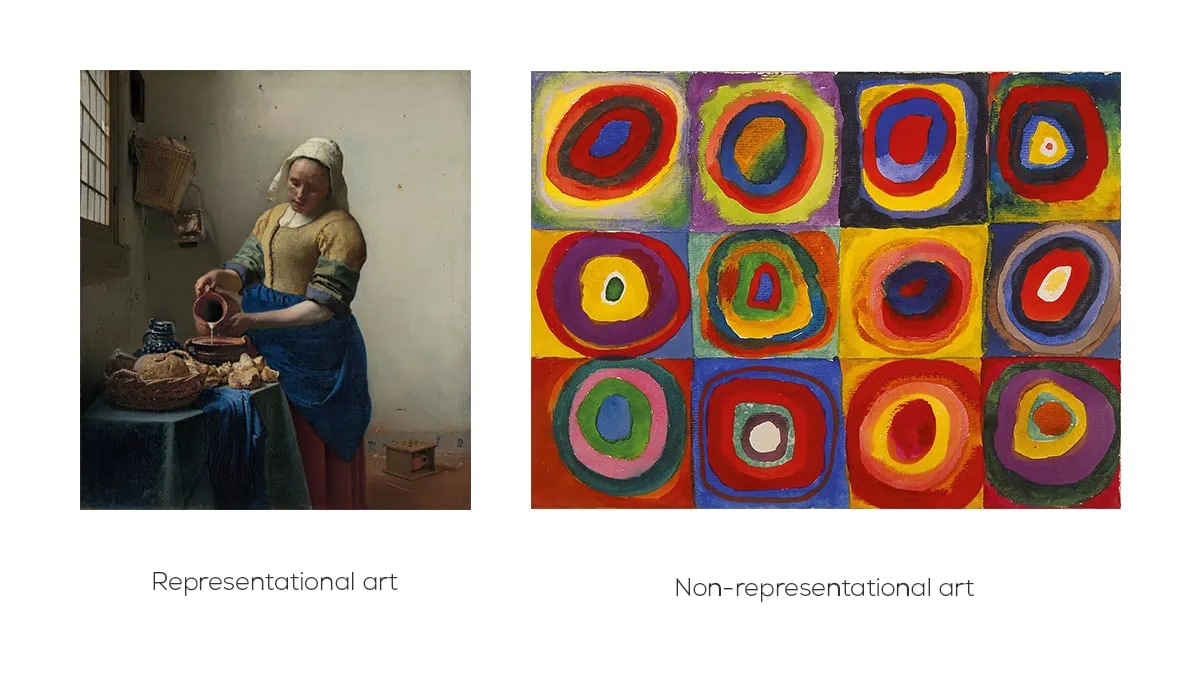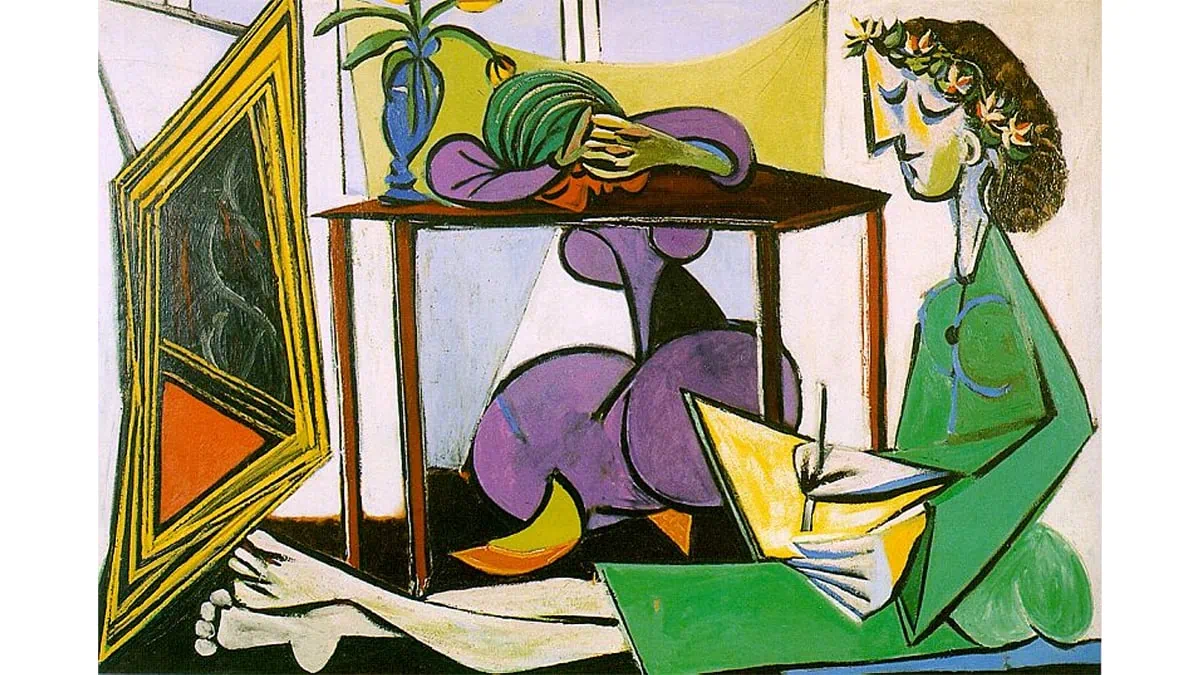Tell me the first thing you notice in art .
I am sure your eyes fall for the subject that it consists of.
A subject is the most significant part of art.
It is the primary reason to produce a painting that brings the artist’s perspective in front of his/her viewers.
Its colors, shapes, and texture capture your attention.
That is what representational art means.
A painting whose compositions are known to an individual, such as trees, cars, beds, or humans.
For better understanding, here I present the blog that answers all the questions about representational art, its type, and examples.
Table of contents
- Backstory of Representational Art
- What is Representational Art? (Types & Examples)
- 5 Representational Art: Paintings & Artists
- What is Non-Representational Art?
- The Difference: Representational vs. Non-Representational Art
- Significance of Representational Art
- To Conclude
- Hello People
- Frequently Asked Questions
Backstory of Representational Art

Before talking about the history of representational art, can you tell me what you see in the above picture?
A painting of a bedroom consists of a bed, table, chair, window, and a few frames on the wall, right?
Subjects that are easily recognized by viewers are representational art.
In an early age, people used to paint the cave, which was the beginning of representational art.
They used to draw pictures of animals, humans doing various activities and more.
Everything was related to the surroundings that we witnessed in our lives.
Have you seen the Venus of Willendorf?
This art is said to have been one of the earliest representational works of art that was produced 25,000 years ago.
The stone age (2,000,000–10,000 B.C.E.) was signified as the representative art period.
The drawings, sculptures, and paintings created during this era were often portrayed as real people, gods, or goddesses.
It was used to describe the tasks they used to perform or their nature.
Suggested Read: Form in Art

When middle age hit, the focus mainly changed to religious subjects, such as paintings of Jesus or arts explaining the culture.
It depicted the heritage of the country, which fell under the category of representational art.
During the Renaissance period, artists like Leonardo da Vinci and Michelangelo produced exceptionally authentic paintings.
They created an example of representational art with their artistic skills.
At this time in art history, artists were commissioned to paint royal portraits that depicted real human figures.
The majority of famous paintings that we witness today demonstrate representative art.
Now that you know the backstory of representational art, why not dive into its meaning, its types, and some representational painting?
Suggested read: 24 Renaissance Facts
What is Representational Art? (Types & Examples)

What does representational art mean?
This is the most frequent question asked by any art lover.
In the simplest words, the definition of representational art can be paintings and sculptures that are copied from real objects.
It can be a still life painting or a portrait of a person.
If you ask, why do artists create representative art that is just a replica of common objects?
The answer is simple—to convey a strong visual to the admirers.
While creating a painting, its subject is the primary thing that you look at.
It mirrors the thoughts of an artist, a message that he/she wants to convey, the idea behind the painting, a perspective on life, and so on.
This contributes to the main reason why representative arts were created in the first place.
A specific way to define reality in a creative manner.
Even statues were known as representational art.
“The Statue of Liberty” is the most popular example.
There is another popular example of well-defined representational art by Da Vinci.
Yes, you guessed it right! It’s the famous Mona Lisa, which is an iconic painting describing the facial expression of a woman.

I mean, just look at it!
A simple crayon drawing that turned into priceless art explains how representing in art is essential.
But this art form also has various divisions.
Representational art is of four types:
- Realism
- Impressionism
- Idealism
- Stylization.
An artistic approach that seeks to portray reality in the most accurate way possible.
You can even look into some famous impressionist paintings that depict the veracity of the world.
To understand better, let’s witness some of the famous representational painters and their works!
5 Representational Art: Paintings & Artists
Numerous famous painters produced representational styles, but there are exceptions whose paintings blew people away.
1. Four Apples by Paul Cezanne (1881)

An oil painting representing four apples.
How simple can it be?
Paul Cezanne’s art exists as a brilliant example of representational art.
The main objective of painting four apples was to focus on the color theme.
He wanted to create a realistic artwork that would not welcome any thick brushstrokes or intense contrast.
Just a few simple shades, a common subject, and a clear background.
With the title Four Apples, no one could misunderstand the circles other than what Cezanne wanted to explain, which was apples.
His other work, which shows a group of two or more men playing cards, is again a masterpiece.
Yes, I am talking about “The Card Players,” which depicts men playing cards.
What a work!
2. Valencian Fishermen by Joaquín Sorolla (1895)

Another effortless painting from the Impressionist movement featuring two fishermen.
A simple task is portrayed by Joaquin Sorolla in the most uncomplicated way.
He depicted exactly what his painting is labeled as.
Two fishermen are engrossed in working on fishing equipment.
With the assumption of what Valencian fisherwomen would look like, he represents the art in the most relaxed way.
The daily work of a fisherman cannot be illustrated in a simpler way than this.
Suggested read: 9 Impressionist Artists
3. The Surrey Canal, Camberwell, by Algernon Newton (1935)

How beautiful can a painting be? I guess Algernon Newton’s beautiful!
As soon as you enter this representational art, a sudden sense of stillness runs through your eyes.
The art illuminates a calm feeling with a serene view.
Newton was fond of depicting streets, views of canals, and the areas of London where he could explore nature’s beauty.
The Surrey Canal is one of his masterworks, which shows representative art paintings.
4. Olympia by Edouard Manet (1863)

The most controversial artwork from the 1860s is Olympia by Manet.
Why controversial?
The subject that the painting represents was a bit modern for that time period.
The nude picture of a woman is also representative art, which shows the naked beauty of a female figure.
It was hard to accept the art but it was considered to be a wonderful work of modern art.
Manet was also given the title of the most notorious artist during the 1860s.
Representational art could be anything that is known to humans.
Suggested read: Analysis of Dance by Matisse
5. Luncheon of the Boating Party by Pierre-Auguste Renoir (1881)

Observe this artwork carefully.
The most detailed version of a lunch party, where we can notice the common celebration of human lives.
Isn’t it amazing?
Even if you didn’t read the title, you can figure out its subject by just glancing at the painting.
“Luncheon of the Boating Party” is another masterpiece of representational art.
It passes a cheerful energy where people emerge in food, wines, and different activities.
It was interesting to learn about different representational pieces of work. How about we look into the opposite factor as well?
Didn’t get me? Keep reading!
What is Non-Representational Art?
Non-representational art is just the opposite of representational art.
The imagery is different from what the real world depicts.
Representing art in a not-so-descriptive way is your non-representational art.
It is also a synonym for the abstract paintings that we witness today.
You can call it abstract art as well.
The line that draws a difference between representational art and non-representational art is thinner.
We all know that art is subjective and can be classified depending on the person .
Therefore, non-representational art means a piece that is described by lines, colors, shapes, and texture.
It doesn’t portray any subject; rather, the colors and shapes in art are the primary theme.
Let me give you an example that can help you understand the definition behind non-representational art.

Rothko’s White Center (Yellow, Pink, and Lavender on Rose) is one of the examples of non-representational art that portrays an artist’s thoughts through its colors.
Now you know what I mean by non-representational art.
You know the best part about this type of art? They look gorgeous on walls that complement their colors.
Don’t you feel like owning one? Whether it is Mark Rothko reproduction paintings or Kandinsky, get your art with just one click.
The Difference: Representational vs. Non-Representational Art

To learn in a better way, let’s differentiate between representational and non-representational art!
| Representational Art | Non-Representational Art | |
| 1. | Represents realistic images | Represents imagery that does not reflect actual appearance |
| 2. | The subjects are quite obvious to the viewer | It is subjective, depending on the artist |
| 3. | It may show a certain level of abstraction | It is completely abstract |
| 4. | This includes animals, places, objects, humans, or any event. | This includes shapes, color, lines, or texture. |
In an easy manner, this is the meaning of representational art.
Significance of Representational Art
Why is representational art important?
Before I answer this, let’s assume that there is no such thing as representational art.
What would an artist have painted?
Just a few colors define shapes and textures in art with no exact meaning, right?
Won’t it be tedious to look at? I am sure it will.
A representational work of art brings life to the painting or sculpture.
They define the art in a way that captivates the viewers.
Widely known among audiences and critics, representational art is the most popular art form, despite how many other forms get introduced.
It is considered a key factor in the art genre that provides a standard quality of pieces.
The accuracy of each piece of art, like landscape painting, seascapes, humans, or nature, is based on how realistic it appears to be.
This separates the exceptional pieces from the mediocre work.
There is also another term called representational abstract art.
Do you know the definition of this art form?
It is art that could be easily recognized by the audience as more abstract in nature.
For better understanding, look at the image below.

This is a representational abstract artwork by Pablo Picasso, “Interior with a Girl Drawing.”
Although the art is based on abstract shapes, we can clearly depict a woman sitting.
This shows that without representative artwork, the meaning won’t be definite!
To Conclude
Decades have passed, but this genre is a constant part of the art world.
Each art movement shows different styles of representational drawing according to the artist’s perspective.
We have already examined a few famous representational arts.
Their clear images have millions of meanings.
In a nutshell, this art captures subjects that are real and come alive.
This makes the viewers easily acknowledge the theme that the artist attempts to portray.
One art genre with various interpretations. Wow!
Hello People
With the thought of keeping the reading interesting for you, I hope you find the blog informative.
I know that each perspective varies according to the people.
Why not share your views with me via comments, where I can read your valuable feedback?
I would love to take a look at the art from different eyes.
I’ll be back with another piece of writing super soon.
Till then, keep reading and exploring!
Frequently Asked Questions
Art that includes portraits, landscape paintings, still-life images, historical views, and statues can be examples of representational art.
Art that shows realistic images is known as representational art, and art that shows abstract images that don’t depict any real objects is known as non-representational art.
The representational meaning suggests depictions in art that show known objects of life.
The artworks that clearly depict real objects are in the representation style.




